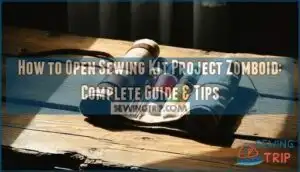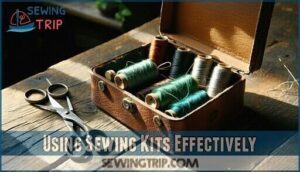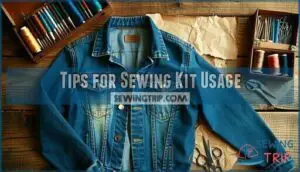This site is supported by our readers. We may earn a commission, at no cost to you, if you purchase through links.
 To open a sewing kit in Project Zomboid, right-click it in your inventory and choose "Open." This action reveals its contents, which typically include needles, thread, and sometimes fabric strips—essential tools for tailoring and survival.
To open a sewing kit in Project Zomboid, right-click it in your inventory and choose "Open." This action reveals its contents, which typically include needles, thread, and sometimes fabric strips—essential tools for tailoring and survival.
Sewing kits are lifesavers for repairing clothes or even stitching up wounds in a pinch. Keep an eye out for them in bathrooms, bedrooms, or crafting areas.
They’re small but mighty, so don’t underestimate their value. Once opened, the kit’s items will move to your inventory, ready for use.
Curious about maximizing your tailoring skills? There’s more to learn about making the most of these kits!
Table Of Contents
Key Takeaways
- Right-click the sewing kit in your inventory and select "Open" to access its contents, including needles, thread, and fabric strips.
- Look for sewing kits in closets, bathrooms, and garages, as these locations have the highest spawn rates in Project Zomboid.
- Use sewing kits for tailoring and survival tasks like patching clothes, adding padding, or suturing wounds.
- Prioritize materials like denim and leather strips for stronger repairs and better durability against zombie encounters.
Finding Sewing Kits
You’ll find sewing kits in various locations throughout Project Zomboid, with the highest spawn rates in bathroom counters at 64% and closet crates at 99%.
Sewing kits are survival gold—find them in closets (99%) and bathroom counters (64%) for tailoring and wound care essentials.
These essential containers also appear in bedrooms, general stores, and through foraging in specific biomes like forests and farmland.
Locations in Project Zomboid
In Project Zomboid, sewing kits can appear in both urban spawns and rural locations.
Check bathrooms, closets, and shelves for higher chances. Loot tables favor spots like garages, general stores, and sewing shops.
Biome variety matters too—search BirchForest or DeepForest areas. With spawn rarity varying, patience is key while exploring ingame locations for that essential SewingKit.
Remember that TSA guidelines allow small scissors in carry-ons, making sewing kits a practical real-world travel item.
Spawn Chances and Biomes
Sewing kits in Project Zomboid appear in specific foraging biomes like BirchForest and DeepForest.
Location specificity matters—closets and garages offer a 99% chance, while counters and shelves range from 8% to 16%.
Spawn quantities vary, with crates holding up to nine, and understanding zombie spawn rates can help players optimize their search.
Zombie density and loot settings can influence availability, so check high-probability spots for better results, considering the impact of zombie spawn rates and overall loot settings.
Loot Settings and Zombie Density
Zombie density and loot rarity go hand in hand, shaping resource scarcity in Project Zomboid.
Higher zombie populations boost the chance of sewing kits spawning, especially in cluttered locations.
Custom settings let you tweak loot and zombie density for balanced gameplay.
Adjust initial spawn zones carefully to avoid frustration while ensuring essential items like sewing kits remain accessible in spawning locations.
Opening Sewing Kit Project Zomboid
To access your sewing kit in Project Zomboid, you’ll need to either equip it or place it on the floor. This container mechanic guarantees easy inventory management, but equipping issues can arise if your hands are full.
Once opened, the kit provides access to sewing supplies like needles and thread, essential for tailoring tasks. A quality kit should include essential tools for sewing for efficient repairs.
Floor placement can be handy during crafting sessions, keeping everything within reach. Mastering kit accessibility streamlines your sewing tutorial experience and keeps your needlework efficient and organized.
Using Sewing Kits Effectively
Using a sewing kit effectively means keeping your gear in top shape and patching yourself up when things go south.
Whether you’re repairing a jacket or suturing a wound, it’s a handy tool that can make survival a bit easier.
Tailoring and Suturing Wounds
Once you’ve opened your sewing kit in Project Zomboid, it’s handy for tailoring and suturing wounds.
Use needle and thread to stitch deep wounds, though expect more suture pain compared to medical tools.
Tailoring skill boosts repair quality on clothing, enhancing material protection against zombie scratches.
For specialized gear, consider exploring Project Zomboid tailoring.
Remember, padded layers improve clothing durability, keeping you safer during encounters.
Repairing and Creating Clothing
To repair clothes in Project Zomboid, use a sewing kit with needles, thread, and materials like denim or leather strips.
Repair clothes effectively using needles, thread, and durable materials like denim or leather strips for stronger, longer-lasting protection.
Ripping clothes provides fabric for patching holes, improving repair quality and clothing durability.
Tailoring skill boosts results, ensuring better material protection. Remember, padded repairs enhance defense, making your gear last longer against zombie encounters.
Essential techniques include hemming and patching. Don’t forget to prioritize durable materials!
Storing Items and Managing Inventory
To keep your Sewing Kit functional, smart inventory management is key. With limited capacity and weight reduction perks, focus on efficient item organization.
Store only what’s needed for tailoring and suturing.
- Prioritize needles, threads, and scissors.
- Use Sewing Storage for quick access.
- Avoid overloading to maximize weight reduction.
- Check Sewing Locations for restocking essentials to ensure your kit remains functional and you can take advantage of weight reduction perks.
Tips for Sewing Kit Usage
Using a sewing kit efficiently can make a big difference in both your survival and inventory management.
Focus on carrying lightweight materials like thread and prioritize using denim or leather strips for stronger repairs.
Prioritizing Denim and Leather Strips
In the context of repair quality and durability enhancement, denim and leather strips are your best friends.
These materials offer superior protection differences compared to ripped sheets, making them ideal for mending clothing.
Use scissors to obtain them, as they’re essential for the best applications in tailoring.
Save ripped sheets for training and prioritize these strips for serious repairs.
Adding Paddings and Enhancing Durability
Adding padding to your clothing boosts durability and scratch resistance while offering bonus protection.
Use denim or leather strips from your sewing kit for the best results. Layering effects improve clothing condition, especially during zombie encounters.
Focus on clothing repair with quality padding materials to maximize protection bonuses. Quality tools improve sewing accuracy.
Your gear will last longer and keep you safer with the right sewing kit.
Managing Sewing Kit Weight and Capacity
Balancing your sewing kit’s encumbrance limits is key to inventory optimization. With a weight reduction of 50%, it’s smart to pack light—needles, threads, and small tools fit well within its 2-capacity limit.
Consider actual sewing kit weight when organizing your supplies. Prioritize items based on size and condition to avoid overloading.
Managing item size guarantees quick access for repairs, improving clothing condition and your sewing skill efficiency. This approach ensures that you can work efficiently, making the most of your sewing kit.
Frequently Asked Questions (FAQs)
How do I tailor clothes in Project Zomboid?
To tailor clothes in Project Zomboid, equip or place the sewing kit, gather needles, thread, and fabric.
Right-click the clothing, choose "Inspect," then repair holes or add padding with denim or leather strips.
How do I use the sewing kit?
Think of the sewing kit as a treasure chest for tailoring.
Equip it or place it on the ground, then right-click to access its contents.
Use it to patch, repair, or fortify your clothes.
Are sewing kits still available?
Yes, sewing kits are still available in Project Zomboid.
You’ll often find them in closets, garages, or general stores.
They’re essential for clothing repairs, so keep an eye out while scavenging!
How to use sewing kit in Project Zomboid?
Don’t worry, using the sewing kit is simple!
Equip it or place it on the ground, then right-click clothing to patch or repair.
Keep needles, thread, and fabric handy for better results.
How do you open the tailoring menu in Project Zomboid?
To open the tailoring menu in Project Zomboid, right-click your clothing, then select "Inspect."
This shows the repair tab, where you can patch holes, add padding, or fix garments using materials like thread.
How to get needles out of a sewing kit?
Equip the sewing kit or place it on the ground.
Right-click the kit, select "Open," and a window will show its contents.
Drag the needle to your inventory to remove it.
How do you tailor clothes in zomboid?
It’s surprisingly simple to tailor clothes in Zomboid.
Right-click the item, choose “inspect,” then select the repair tab.
Use scissors, thread, and fabric like denim or leather strips to patch, fortify, or add padding.
How do I get more needles and thread if my sewing kit runs out?
Search bathrooms, closets, or garages for new sewing kits that often include needles and thread. Rip clothes to find thread, or loot general stores, cabinets, and lockers for these essentials.
Can sewing kits be upgraded or modified?
Think of a sewing kit as a steadfast toolbox—it can’t be upgraded or modified directly.
Instead, collect better tools like high-quality needles, threads, or scissors to enhance your tailoring efficiency and crafting success.
What tools work best with sewing kits?
The best tools for sewing kits are needles, thread, and scissors.
Needles guarantee precision, thread binds effectively, and scissors cut fabric cleanly.
Together, they handle tailoring, repairs, and creating durable clothing for survival.
Conclusion
Mastering how to open a sewing kit in Project Zomboid mightn’t feel like unraveling the secrets of the universe, but it’s a game-changer for survival.
Treat these small kits like treasure chests—each item inside can patch a tear or save a life.
Once you’ve opened one, plunge into tailoring, repair gear, or even protect yourself with enhancements.
Keep your sewing kit handy, stay prepared, and remember—every thread counts in the fight to survive.
- https://www.reddit.com/r/projectzomboid/comments/xydwle/how_do_you_take_the_sewing_needle_out_of_the_kit/
- https://sewyoursoul.com/how-to-use-sewing-kit-project-zomboid/
- https://pzwiki.net/wiki/Sewing_Kit
- https://www.youtube.com/watch?v=J7Doczc6xVQ
- https://theindiestone.com/forums/index.php?/topic/80463-cant-put-scissors-in-a-sewing-kit/











